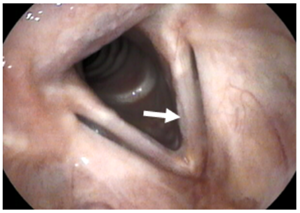 Vocal fold scar is characterized by scarring of the vocal fold tissue. Sulcus vocalis is characterized by a furrow along the edge of the vocal fold due to thinning or loss to the vocal fold tissue. Both of these voice conditions impair vocal fold vibration, resulting in an abnormal voice quality.
Vocal fold scar is characterized by scarring of the vocal fold tissue. Sulcus vocalis is characterized by a furrow along the edge of the vocal fold due to thinning or loss to the vocal fold tissue. Both of these voice conditions impair vocal fold vibration, resulting in an abnormal voice quality.
Causes of Vocal Fold Scarring
Vocal fold scar and sulcus vocalis may form due to unhealthy or inefficient voice use, intubation related trauma (from a breathing tube), history of laryngeal (voice box) infection, or radiation therapy. Some cases of sulcus vocalis may be congenital (present at birth).Sulcus Vocalis Symptoms
Symptoms may include hoarseness, breathiness, and a “weak” or low-powered sounding voice. There may be occasional voice breaks, particularly at the beginning of words. To compensate for abnormal vocal fold vibration, some patients strain their voices, resulting in vocal fatigue and possibly throat discomfort.Diagnosis of Sulcus Vocalis
Our voice care team at the Voice and Swallowing Center has the advanced training and skills necessary to diagnose this voice condition. During the initial visit, you will be assessed by one of our laryngologists and likely, an additional session with one of our voice pathologists. We use cutting-edge diagnostic tests to determine the cause of your voice disorder and to develop your plan of care. Following a thorough discussion of your symptoms and medical history, be expected to undergo the following assessments:- Video Laryngostroboscopy: Using a small camera inserted through the nose or mouth, our specialists are able to assess the health and function of your larynx (voice box) and determine the presence of any vocal fold growths or abnormalities.
- Perceptual, Acoustic, and Aerodynamic Voice Evaluation: This is a comprehensive assessment of multiple voice parameters completed by the voice pathologist.
Non-Surgical Treatment for Sulcus Vocalis
Treatment for vocal fold scar and/or sulcus vocalis varies depending on the degree of impaired vocal fold vibration and the severity of the patient’s symptoms/how the voice changes impact activities of daily living. If your voice condition affects your activities of daily living and quality of life, you may be evaluated by one of our voice pathologists to determine your candidacy for voice therapy. A therapy approach with special attention to efficient and healthy voice use may reduce some voice symptoms, particularly vocal strain. In other cases, voice therapy may need to be combined with surgical treatment (i.e. before surgery, after surgery, or both).
Surgical Treatment for Sulcus Vocalis
Treatment options may include in-office steroid injections to the vocal folds in attempt to break up scar tissue, inserting an implant to help bring the vocal folds closer together (laryngeal framework surgery), or injecting a filler into the vocal folds (in-office vocal fold injection augmentation or vocal fold fat injection augmentation).
